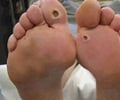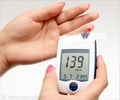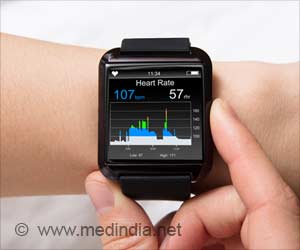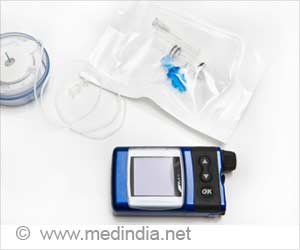Beta carotene was found to protect the people with common risk factor for type 2 diabetes, while gamma tocopherol may increase risk for the disease, say researchers.

"Type-2 diabetes affects about 15 percent of the world's population, and the numbers are increasing," said Atul Butte, MD, PhD, associate professor of systems medicine in pediatrics. "Government health authorities estimate that one-third of all children born in the United States since the year 2000 will get this disease at some point in their lives, possibly knocking decades off their life expectancies."
Butte is the senior author of the new study, which will be published online Jan. 22 in Human Genetics. The first author, Chirag Patel, PhD, is a former graduate student in Butte's lab and now a postdoctoral scholar at the Stanford Prevention Research Center.
The findings point the way to further experiments that could establish whether beta carotene and gamma tocopherol are, respectively, protective and harmful themselves, or merely "markers" whose blood levels dovetail with the presence or absence of some other substance, process or defect that is a true causal factor.
Moreover, the fact that both beta carotene and gamma tocopherol interact with the same gene variant to influence diabetes risk, albeit in opposite directions, suggests that the protein the gene called, SLC30A4, codes for may play a crucial role in the disease. Indeed, that protein is relatively abundant in insulin-producing islet cells of the pancreas, where it aids the transport of zinc into those cells. This, in turn, triggers the release of insulin, whose adequate secretion by the pancreas and efficient uptake in muscle, liver and fat tissue counters the dangerous buildup of glucose in the blood and, in the long run, the onset of type-2 diabetes.
The genomes of some 50 to 60 percent of the U.S. population carry two copies of that very gene variant, which previous studies have shown to confer a slightly increased risk of contracting type-2 diabetes. This variant was one of 18, each found by other researchers to have a mild association with type-2 diabetes risk, that the Butte team incorporated into its analysis.
Advertisement
The most well-studied gene variations are substitutions of one type of chemical unit of DNA for another one at a single position along the genome. "It's like a single-letter spelling change," said Butte. "'Grey' versus 'gray' may not matter much, if at all. But when 'grey' turns into 'grew,' you might have some serious semantic issues." The genome contains millions of spots at which such differences occur, so advanced statistical techniques must be employed to screen out "frequency differences" between the "diseased" and "healthy" groups that are, at bottom, the mere results of blind chance.
Advertisement
A few years ago, Butte and his associates designed an approach analogous to the GWAS: the EWAS, or environment-wide association study. Unlike the genome, which is huge but finite (about 3 billion chemical units long), the environment contains an infinite number of substances, from dietary micronutrients to synthetic pollutants, to which a person might be exposed over a lifetime. But increasing numbers of exposures are being cataloged by investigators — including, for example, scientists at the federal Centers for Disease Control and Prevention who conduct massive biennial screenings to collect data that can guide public-health policy decisions. This ongoing endeavor, called the National Health and Nutrition Examination Survey, involves a detailed analysis of substances in blood drawn from thousands of volunteers along with their heights, weights, blood pressures, fasting blood-glucose levels and other indicators of their medical status.
In 2010, Patel, Butte and their colleagues published the results of the first-ever EWAS, in which they combed large public databases to compare people with or without high blood-glucose levels — a defining marker of type-2 diabetes — in pursuit of differences between the two groups' exposures to myriad environmental substances. The analysis fingered five substances, including both beta carotene, found in carrots and many other vegetables, and gamma tocopherol, which is relatively abundant in vegetable fats such as soybean, corn and canola oils and margarine.
The Stanford investigators learned that the NHANES contained data on numerous individuals' environmental exposures and, for many of the same individuals, their genomic compositions. This enabled the researchers to perform a novel study pairing each of the 18 type-2-diabetes-implicated gene variants with each of the five suspect environmental substances to see how, for individuals carrying a particular gene variant, different blood levels of a given substance correlated with those individuals' blood-glucose levels.
None of the genetic factors studied in isolation had shown a particularly impressive impact on type-2 diabetes risk. But when they were paired off one by one with the environmental factors, a couple of statistically robust results jumped out. First, for those carrying two copies of the variant in SLC30A4, higher beta-carotene levels correlated with lower blood-glucose levels. "This vitamin was already known as being 'good' with respect to type-2 diabetes, so it was no surprise that we saw it, too," said Butte. "But it was reassuring, as it suggested we were doing things right, and interesting to find it paired with SLC30A4."
The second finding was at once novel and disconcerting. High blood levels of gamma tocopherol appeared to be associated with increased risk for the disease.
The Butte lab is now gearing up to perform studies in which purified beta carotene and gamma tocopherol will be fed to lab mice. This may show whether those substances themselves are critical to preventing or accelerating the onset of type-2 diabetes. It also may throw light on precisely how these substances affect the production or performance of the protein for which the implicated gene codes.
"We can't say, based on just this study, that 'vitamin E is bad for you,'" said Patel. He noted that blood levels of alpha tocopherol — another form of vitamin E that predominates in most supplements — showed no deleterious interaction with the predisposing gene variant in the new study.
But maybe it can't hurt to eat a few more carrots.
Source-Eurekalert















